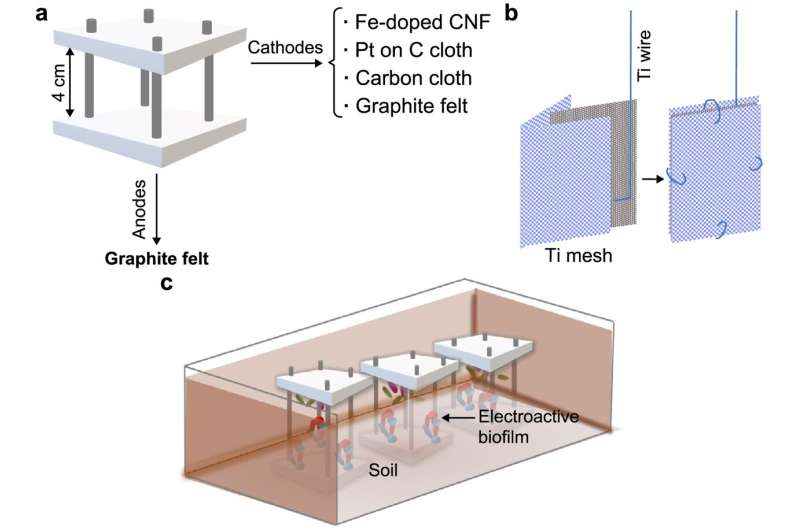Carbon-based cathodes impact biofilm composition and performance in soil microbial fuel cells

In the context of increasing energy demands and environmental concerns, renewable energy solutions are crucial for achieving net-zero emissions by 2050. Microbial electrochemical technologies, such as SMFCs, are cost-effective and environmentally friendly, making them an attractive option for green energy systems. SMFCs utilize endogenous microorganisms present in soil to convert organic matter into electricity, offering a sustainable energy source and a self-powered in situ bioremediation strategy for contaminated soils.
Cathode materials play a significant role in the performance of microbial fuel cells. Researchers recently compared the performance of membrane-free air-cathode SMFCs using four different cathodes: carbon cloth, Pt-doped carbon cloth, graphite felt, and an innovative Fe-doped carbon nanofibers electrode. The researchers conducted electrochemical tests over extended periods, along with microbial taxonomic analyses, to assess the effect of electrode materials on biofilm formation and electrochemical performance.
In their study published the journal Environmental Science and Ecotechnology, researchers from University of Bath revealed that Fe-doped carbon nanofibers and Pt-doped carbon cloth cathodes yielded stable performances, with peak power densities of 25.5 and 30.4 mW m−2, respectively. Graphite felt cathodes demonstrated the best electrochemical performance, with a peak power density of 87.3 mW m−2. However, they also exhibited the greatest instability.
An examination of microbial communities found differences between anodic and cathodic communities. Anodes were predominantly enriched with Geobacter and Pseudomonas species, while cathodic communities were dominated by hydrogen-producing and hydrogenotrophic bacteria. This suggests that hydrogen cycling could be a possible electron transfer mechanism. Additionally, the presence of nitrate-reducing bacteria in combination with cyclic voltammogram results indicated that microbial nitrate reduction occurred on graphite felt cathodes.
The use of innovative Fe-doped carbon nanofiber cathodes provided an electrochemical performance comparable to Pt-doped carbon cloth, offering a low-cost alternative. However, graphite felt outperformed all other electrodes tested but displayed lower reproducibility and higher mass transport losses. Microbial taxonomic profiling of the cathode biofilms revealed the presence of taxa related to oxygen reduction or involvement in utilizing alternative electron acceptors, such as nitrate.
The results of this study can guide future research on low-cost, high-performing SMFCs for practical applications in energy harvesting and bioremediation. By understanding how electrode materials influence microbial communities and electrochemical performance, researchers can accelerate the translation of SMFCs into real-world implementations.
More information:
Arpita Nandy et al, Influence of carbon-based cathodes on biofilm composition and electrochemical performance in soil microbial fuel cells, Environmental Science and Ecotechnology (2023). DOI: 10.1016/j.ese.2023.100276
Provided by
Chinese Society for Environmental Sciences
Citation:
Carbon-based cathodes impact biofilm composition and performance in soil microbial fuel cells (2023, May 12)
retrieved 12 May 2023
from https://techxplore.com/news/2023-05-carbon-based-cathodes-impact-biofilm-composition.html
This document is subject to copyright. Apart from any fair dealing for the purpose of private study or research, no
part may be reproduced without the written permission. The content is provided for information purposes only.
For all the latest Technology News Click Here
For the latest news and updates, follow us on Google News.
